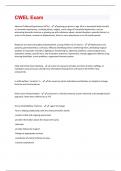CWEL Exam
Adverse Childhood Experiences (ACEs) - growing up (prior to age 18) in a household with stressful
or traumatic experiences, including abuse, neglect, and a range of household dysfunction, such as
witnessing domestic violence or growing up with substance abuse, mental disorders, parental discord, or
crime in the home, removal or displacement, three or more placements in an 18 month period.
Response to trauma throughout development: young children (2.5-6 years) - helplessness and
passivity, generalized fear, confusion, difficulty identifying what is bothering them, attributing magical
qualities to traumatic reminders, fighting or threatening bx, attention problems, sadness/depression,
separation anxiety, specific fears, low frustration tolerance, hyperactive, moody, aggressive defiant, lying,
learning disabilities, social problems, suppressed immune system
Child and Family Team Meeting - center of casework activities and how all other staffings, or
mandatory case processes should have information flowing from and back to the CFTM. 5 key
components.
In child welfare, "practice" is - the means by which individuals and families are helped to change
their bxs and circumstances
Illinois Core Practice Model - anchored in a Family Centered, trauma informed, and strength based
approach, often times referred to as FTS
9 Core Child Welfare Practices - -agent of change
-form a helping relationship with the child and his/her family
-conduct initial and ongoing assessment
-provide information about the impact of trauma
-advocate
-provide behavioral support
-linkage to appropriate services
-coordinate all child and family services
-cultural competence
,Without family connectedness child is at risk for - instability, depression, and even unemployment
and delinquency
CFTM 5 key components - Engagement, full disclosure, open participation, collaboration, planning
for permanency.
Response to trauma throughout development: school age children (6-11 years) - physical
complaints, bedwetting, school failure/absenteeism, behavioral problems, attention problems, fighting
or threatening bx, guilt feelings, acting like a parent to siblings, depression, defiant, lying, stealing,
learning disabilities, inappropriate emotional responses, self-blame, hypersensitivity to physical contact,
difficulties coordinating and balancing
Response to trauma throughout development: adolescents (12-18 years) - antisocial bx, eating
disorders, runaway, dating violence, depression, suicidal, substance abuse, sleeping disorders, school
failure, absenteeism, relationship problems, acting like a parent to siblings, loses time, difficulty seeing a
future for oneself
3 kinds of stress - positive stress, tolerable stress, toxic stress
postive stress - moderate, short lived stress responses
tolerable stress - More intense stress responses that allow enough time to recover, or occur in a
relatively safe environment with the presence of supportive adults
toxic stress - Strong, frequent or prolonged activation of the body's stress management system,
without access to supportive adults
6 protective factors - Existing strengths of the family.
Parental resilience
, (strong and flexible)
social connections (parents need friends)
knowledge of parenting and child development
concrete supports in times or need
social and emotional competence of children
parent-child relationship
Guiding principles for children who have experiences trauma - (pyramid from bottom to top)
feeling safe (active process), regulating overwhelming emotions, building trust in relationships, making
meaning, looking to the future
vicarious trauma - An occupational hazard for people in the helping professions, where a process
of change occurs because you care about other people who have been hurt, and are responsible to help
them.
6 protective factors in everyday language - 1. Be Strong & Flexible
2. Parents Need Friends
3. Being a Great Parent is Part Natural & Part Learned
4. We All Need Help Sometimes
5. Parents Need to Help Their Children Communicate
6. Give Your Children the Love & Respect They Need
First child welfare case was in - New York
DCFS mission statement - Protecting children and supporting families is called the dual mandate.
Even when children are separated from their families, we do not view the children and their families as
separate units and support the children's membership in their families of origin.
DCFS is ruled by ____ that become ______ and are made into ______. - laws, rules, procedures




